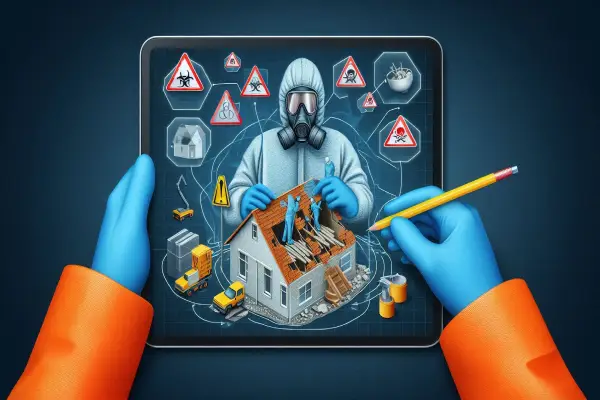Asbestos, once hailed for its fire-resistant properties, has become infamous for its health risks. Understanding what asbestos is, its various types, and where it might be found in our homes and workplaces is crucial for anyone seeking to protect their well-being.
This article explores the dangers of asbestos exposure, the specific health impacts it can have on the body, and the steps necessary for safe removal and disposal, in accordance with Asbestos Disposal Regulations. We will also cover alternatives to asbestos, how to choose the right certified contractors, including cost considerations, and the role of Asbestos abatement professionals.
Whether facing potential exposure or wanting to educate yourself, this guide provides essential knowledge, including advice on how to handle asbestos-containing materials safely.
Key takeaway: Ensuring compliance with asbestos regulations is crucial for both residential and commercial property owners to manage health risks effectively.
What is Asbestos?
Asbestos is a naturally occurring mineral that was widely used in construction and manufacturing due to its durability and resistance to heat, but it is now recognised as a hazardous material that poses significant health risks to humans.
This fibrous substance has been linked to severe diseases, including mesothelioma and lung cancer, and is regulated under the Control of Asbestos Regulations 2012 to ensure the safety of residents and properties across London and the UK.
What are the Types of Asbestos?
Understanding asbestos types is essential, and engaging with Asbestos Testing Services can help identify these in properties.
There are six main types of asbestos, categorised into two groups: serpentine and amphibole, with chrysotile being the most commonly used type in various industries, whereas amosite and crocidolite are known for their greater risk to health.
Understanding these types is crucial for recognising their distinct properties and potential hazards. For instance, each type varies in fibre structure and durability, leading to different applications in construction and manufacturing industries.
- Chrysotile: The most prevalent type, featuring curly fibres and flexibility; commonly found in roofing sheets and insulation.
- Amosite: Known as brown asbestos, recognised for its strength and thermal resistance; frequently used in insulation and fireproofing.
- Crocidolite: Also called blue asbestos, notable for its thin, straight fibres; primarily used in high-temperature insulation but poses serious health risks.
- Other types, including tremolite, anthophyllite, and actinolite, are less common but still dangerous when encountered.
Exposure to these materials is linked to severe health issues, underscoring the importance of safe handling and awareness in environments where asbestos may be present. Our experts at Ecorex recommend regular surveys and inspections to identify asbestos presence and ensure compliance with safety standards.
Why is Asbestos Harmful?
According to the Environmental Protection Agency (EPA), proper handling and disposal of asbestos waste materials are crucial to minimize health risks.
Asbestos is harmful primarily due to the inhalation of its microscopic fibres that can lead to serious health issues, including lung cancer, asbestosis, and other respiratory diseases, creating significant risks for individuals exposed to hazardous materials in residential and commercial properties alike. Certified professionals should always be engaged for asbestos removal to minimise these health risks. During removal, the use of HEPA Vacuum Cleaners and Negative Air Machines is essential to ensure safe air quality.
How Does Asbestos Affect the Body?
Asbestos affects the body primarily when its fibres are inhaled, which can lead to a buildup of scar tissue in the lungs, resulting in serious diseases such as pulmonary fibrosis, lung cancer, and mesothelioma over time. The use of Respirators and Protective Clothing can help mitigate these risks during exposure.
These harmful fibres enter the respiratory system and eventually settle in the lung tissue, triggering inflammatory responses that contribute to the formation of scarring and cellular damage. Over the years, the accumulation of such effects can significantly impair lung function and overall health. Post-Removal Clearance Testing Procedures are essential to ensure no residual fibres remain.
The timeframes for the development of asbestos-related diseases vary greatly among individuals, often ranging from 20 to 50 years, depending on factors such as the level of exposure and individual susceptibility. Awareness of these risks is crucial for those who have been exposed, as it allows for early detection and management of potential symptoms. Regular health screenings and professional advice can significantly aid in early intervention.
- Understanding the timeline of disease onset is essential for monitoring health.
- Regular screenings can aid in early intervention.
- Educating the public about these dangers can significantly reduce exposure risks.
Where is Asbestos Commonly Found?
Asbestos can be found in a variety of settings, from residential homes to commercial properties. It is commonly present in older buildings within London England, and the UK, often requiring comprehensive surveys to determine its presence.
Asbestos can commonly be found in older residential and commercial properties, particularly in materials such as insulation, floor tiles, roofing, and cement products; thus, residents and property owners should be vigilant in identifying its presence in their properties. Utilizing Air Quality Monitoring Systems is critical in detecting hazardous fibres in these environments.
What are the Risks of Asbestos Exposure?
The risks of asbestos exposure are severe and can include the development of various chronic diseases, prompting the implementation of strict regulations and guidelines for inspections and management of hazardous materials in buildings. Compliance with these regulations, including the Asbestos Waste Transport Regulations, is necessary to protect residents and workers alike.
As many know, asbestos can lead to serious health issues such as lung cancer, mesothelioma, and asbestosis, which are not only debilitating but often fatal.
Compliance with established regulations is crucial to ensuring the safety of occupants in properties where asbestos may be present. By adhering to these protocols, property owners can effectively manage risks and avoid potential legal repercussions.
- Regular inspections play a vital role in identifying the presence of asbestos.
- These assessments allow for proactive measures to be taken, ranging from safe removal to long-term management strategies.
- In doing so, the likelihood of exposure is significantly reduced, benefiting everyone involved.
Ultimately, a commitment to safety through proper regulation and vigilant inspections can safeguard both lives and assets, highlighting the importance of responsible property management.
How is Asbestos Removed?
Ecorex offers comprehensive asbestos removal services, including Asbestos Disposal Services, ensuring that all procedures comply with regulatory standards to protect health and safety.
Asbestos removal is a meticulous process that requires certified contractors who follow strict safety procedures to mitigate risks associated with hazardous materials; this ensures compliance with regulations and protects the health of workers and residents during the removal operation.
What are the Steps of Asbestos Removal?
Proper asbestos removal involves a detailed process that includes professional testing, containment, removal, and disposal to ensure safety and compliance with regulations.
The steps of asbestos removal involve initial testing of materials for the presence of asbestos, followed by a thorough assessment, careful containment, removal by certified contractors, and proper disposal in accordance with regulations to ensure safe management of hazardous waste. Hiring a company like Ecorex, accredited by industry bodies such as the Asbestos Removal Contractors Association, guarantees adherence to these protocols. Additionally, techniques like Asbestos Encapsulation Techniques can be applied when complete removal is not feasible.
Understanding the importance of each step in this process cannot be overstated. Initially, testing is crucial, as it identifies whether any materials contain asbestos fibres that could pose a risk to health. Once asbestos is confirmed, a detailed assessment of the site follows. This includes evaluating the extent of contamination and preparing the area for safe removal. As part of this process, implementing Air Quality Monitoring Systems is essential to ensure that the surrounding atmosphere remains safe.
In the next stage, containment measures are implemented to prevent any airborne fibres from escaping into the surrounding environment. This typically involves sealing off the work area with plastic sheeting and implementing negative air pressure systems. Certified contractors take centre stage during the removal process, utilising specialised equipment to safely eliminate asbestos materials.
- Once removal is complete, the focus shifts to proper disposal.
- This must adhere to strict regulations to ensure that hazardous waste is handled appropriately and does not re-enter the ecosystem.
By meticulously following these steps, individuals can significantly mitigate health risks associated with asbestos exposure, ensuring compliance with all Asbestos Disposal Regulations.
What are the Safety Measures for Asbestos Removal?
Safety measures for asbestos removal are critical and include the use of personal protective equipment (PPE), containment strategies, air monitoring, and adherence to regulations set forth by the Health and Safety Executive and the Environmental Protection Agency (EPA) to ensure compliance and protect the health of all involved.
Along with these essential practices, it is important for companies to employ certified contractors experienced in handling asbestos safely. These professionals are trained to recognise potential hazards and implement the necessary precautions.
- Their expertise ensures that removal processes are conducted efficiently and securely.
- They can provide detailed plans for containment and clean-up, minimising the risk of exposure.
Compliance with local regulations, including the Asbestos Disposal Regulations, is not merely a legal obligation; it is also vital for safeguarding the well-being of both residents and workers. By following established safety protocols, engaging certified professionals, and using appropriate equipment like HEPA Vacuum Cleaners and Negative Air Machines, the overall health risks associated with asbestos can be significantly mitigated, creating a safer environment for everyone involved.
What are the Disposal Methods for Asbestos?
Proper disposal is a critical component of asbestos management, ensuring that hazardous waste is handled safely and in compliance with environmental standards, including those set by the Environmental Protection Agency (EPA).
Disposal methods for asbestos must comply with strict regulations to prevent environmental contamination; these typically involve sealing asbestos waste in approved containers and transporting it to licensed disposal sites as hazardous waste, ensuring safety for both the environment and public health. Compliance with Asbestos Waste Transport Regulations is essential. Ecorex provides professional collection and disposal services, ensuring that all hazardous materials are managed according to regulatory standards.
What are the Regulations for Asbestos Disposal?
Regulations for asbestos disposal are stringent and are enforced by agencies such as the Environment Agency, which require that all asbestos waste is disposed of at licensed facilities following proper procedures to ensure compliance and minimise health risks.
These protocols are designed not only to safeguard the workers involved in the disposal process but also to protect the surrounding communities and the natural environment from the hazardous effects of asbestos exposure. Compliance is typically monitored through a combination of on-site inspections, reviews of disposal documentation, environmental assessments, and Post-Removal Clearance Testing Procedures.
The following are crucial aspects of asbestos management as per the Control of Asbestos Regulations 2012:
- Proper training: Workers handling asbestos must undergo specialised training to understand the risks, appropriate handling methods, the use of chemicals, and the correct usage of Respirators and Protective Clothing.
- Documentation: Firms must maintain comprehensive records of asbestos material from its initial collection to final disposal, ensuring compliance with Asbestos Disposal Services.
- Public awareness: Community education initiatives are vital to ensure that local residents are informed about potential risks associated with asbestos, which can be facilitated by organizations like the Health and Safety Executive and the Environmental Protection Agency (EPA).
By adhering to these regulations, such as those set by the Environment Agency and the Health and Safety Executive, the likelihood of asbestos-related health issues significantly decreases, thereby ensuring a safer environment for everyone.
What are the Alternatives to Asbestos Removal?
Alternatives to asbestos removal include Asbestos Encapsulation Techniques, which involve sealing asbestos-containing materials to prevent fibre release, and replacing them with safer materials that comply with current building regulations, providing a viable option for property owners concerned about hazardous materials, such as those endorsed by the British Occupational Hygiene Society.
How Much Does Asbestos Removal Cost?
The cost of asbestos removal can vary significantly based on factors such as the amount of material, the type of property, and the specific contractors used, making it essential for property owners to obtain quotes from certified services like Blue A Ltd or Goodbye Asbestos to ensure they comply with safety standards while managing expenses.
Understanding the various elements that contribute to the final price is crucial for making informed decisions. For instance, the size of the affected area plays a significant role, as larger spaces typically incur higher costs due to increased labour and disposal needs. Additionally, the following factors can further influence the overall pricing:
- the type of asbestos present
- the complexity of the removal process
- and the condition of the material as well as obtaining necessary approvals from local councils and other authorities in London England.
On average, homeowners can expect to pay between £1,500 and £3,000 for standard residential removals, but this figure can fluctuate. It’s advisable to engage multiple accredited contractors and compare their quotes. This practice not only ensures cost-effectiveness but also assures quality and compliance with the necessary safety regulations.
How to Choose a Professional Asbestos Removal Company?
Choosing a professional asbestos removal company involves evaluating their accreditation with bodies like the UKAS, expertise in handling hazardous materials, compliance with regulations such as those from the Asbestos Removal Contractors Association, and their track record of successful removal projects to ensure the safety and health of residents and properties.
It’s also wise to inquire if they offer Asbestos Testing Services as part of their package. Selecting the right team can define the overall success of the abatement project. It is crucial to consider important factors that reflect the company’s capabilities.
Begin by verifying their accreditations, which should be with recognised organisations that validate their methods and practices. Experience is equally vital; a company with extensive knowledge in this field is more likely to handle complex cases effectively.
Reviewing their safety standards ensures that they prioritise the well-being of both their workers and the public. To aid in your decision, consider the following tips:
- Request references and read online reviews.
- Inquire about their insurance coverage.
- Ask about their procedures for disposal and decontamination to ensure they comply with City of London guidelines.
- Evaluate their communication and customer service.
Making an informed choice not only protects your environment but also contributes significantly to the health of those who inhabit it.
What Should You Do After Asbestos Removal?
After asbestos removal, it is crucial to conduct thorough testing of the premises to ensure that all hazardous materials have been adequately dealt with, possibly by collecting samples and testing through UKAS accredited labs, and to follow up with inspections to maintain compliance with safety regulations and protect the health of residents.
Once the removal process is complete, individuals responsible for the property should initiate a detailed plan. This involves:
- Conducting air quality tests using advanced Air Quality Monitoring Systems to detect any lingering asbestos fibres that may pose health risks.
- Implementing a monitoring programme that tracks air quality over time, ensuring any potential issues are addressed promptly.
- Establishing regular inspections to verify compliance with local safety regulations, giving peace of mind to all occupants.
- Documenting all findings and actions taken, ensuring a clear record is established for future reference.
These steps not only enhance safety but also provide assurance that the premises are free from hazardous substances.
Frequently Asked Questions
What is asbestos and why is it dangerous?
Asbestos is a naturally occurring mineral that was commonly used in construction materials due to its fire-resistant and durable properties. However, when asbestos fibres are inhaled, they can become trapped in the lungs and cause serious health issues, such as lung cancer, mesothelioma, and asbestosis. The Corporation of London was one of the first to regulate its use.
How do I know if my home or building has asbestos?
The only way to determine if a building contains asbestos is through professional testing. Asbestos abatement professionals can take samples of materials suspected to contain asbestos and have them analysed in a lab for confirmation.
Do I need to remove asbestos from my property?
If asbestos-containing materials are in good condition and not disturbed, they may not pose an immediate threat. However, it is recommended to have a professional assessment done by companies like Asbestos Gone to determine the level of risk and if asbestos removal is necessary.
Can I remove asbestos myself?
No, it is not safe for untrained individuals to attempt asbestos removal. Asbestos fibres can easily be released into the air during removal and cause harm to both the person attempting removal and those nearby. It is important to hire a licensed and experienced asbestos removal contractor for this task.
How is asbestos removed from a building?
The process of asbestos removal involves sealing off the area and using specialised equipment and techniques to carefully remove all asbestos-containing materials. The materials are then properly disposed of at a designated facility, ensuring adherence to Disposal of asbestos waste materials protocols, as outlined in detailed reports. The area is thoroughly cleaned and tested to ensure all asbestos has been removed.
Is asbestos removal expensive?
The cost of asbestos removal varies depending on the size and complexity of the project. However, the potential health risks associated with asbestos exposure make it a necessary and worthwhile investment. It is important to obtain quotes from multiple asbestos removal companies to ensure you are getting a fair price.





